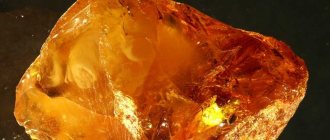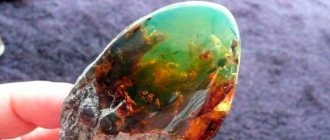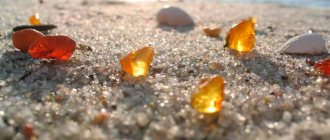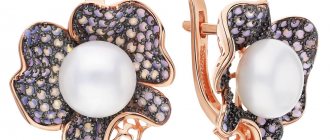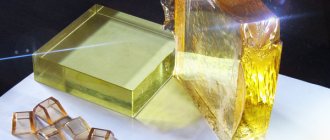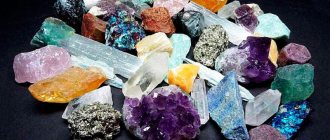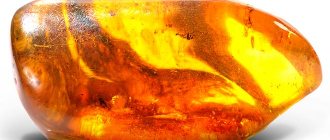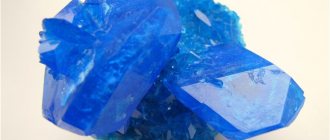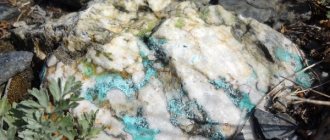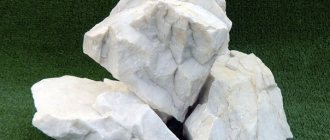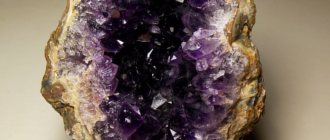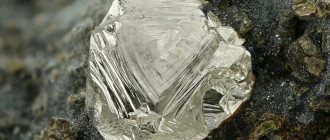/ List of stones / Description of the stone Amber
0
6669
Article rating
Amber stone is hardened resin from coniferous trees. It was formed millions of years ago, in the Paleogene and Upper Cretaceous periods. Known to people since prehistoric times. Now widely used in jewelry, industry, and pharmaceuticals. The gem has magical and healing properties.
Description of the Amber stone
Characteristics of the stone
The name of the stone Amber is of Lithuanian origin. In other languages it was called differently. In French it is "Ambre", derived from the Arabic "anbar". In German it is “berstein”, which means “flammable stone”. The name passed into the Polish, Ukrainian and Belarusian languages, sounds like “burshtyn”. The ancient Greeks called the gem “electron”.
Amber is a mineral without a crystalline structure, classified as a natural resin. It consists of organic acids, oils, interspersed with sulfur, nitrogen, silicon, iron, aluminum and other chemical elements. The stone contains about 8% succinic acid, which is extracted and used industrially.
Description of the properties of natural amber and its physical characteristics:
- Color. The stone has a wide range of colors, there are more than 300 shades, most of them are in the yellow-brown spectrum.
- Hardness – 3-4 points on the Mohs scale.
- Density - 0.97 - 1.11 g/cmᶾ
- Transparency can be full, medium, there are opaque samples.
- There are no lines or cleavages.
- The fracture is conchoidal, viscous.
- Waxy shine.
- The structure is amorphous, in the form of a complex polymer.
- The absorption spectrum is not interpreted
- Luminescence ranges from blue and white to yellow and green.
An important property of the material is its ability to burn; it ignites even from a match. Amber powder is used in aromatic mixtures and in church censers. It was this stone that was first discovered to have the ability to become electrified. The words “electron” and “electricity” come precisely from the Greek name for amber.
Physico-chemical characteristics of amber
Amber is an amorphous framework polymer that does not form crystals. It is not characterized by birefringence, dispersion and pleochroism. Luminescence is bluish-white or yellow-green. The stone is flammable and can catch fire even from the flame of a match. When rubbed, it becomes electrified. Can be polished well. In air it quickly oxidizes (“aging of amber”), changes its color and becomes brittle.
Varieties
The appearance of amber depends on the place of origin
The gem was formed millions of years ago from the resin of coniferous trees. The processes took place in different regions of the world, under different climates. Therefore, types of amber differ from each other in many characteristics. The most valuable is the Caribbean (Dominican) and Baltic stone. The Ukrainian gem, which is part of the Baltic group and is mined in the northwestern regions of Ukraine, is expensive.
Based on some structural features, the following varieties of natural amber are distinguished:
- Succinite or Baltic amber. The most valuable species, which comes from the resin of the Pinus Succinifera species.
- Bokkerit. Opaque and elastic mineral of a dark shade.
- Glessite. Brown opaque stone.
- Gedanite. A yellow gem with a characteristic waxy sheen.
- Stanthienite. Fragile black amber.
- Birmit. A hard mineral from Burma that can be cut.
- Rumenit. Found in the Carpathians in Romania and Ukraine, it is similar to succinite, but contains less succinic acid.
Sometimes amber is divided according to the origin of the stone into Baikal, Brazilian, Sicilian, Mexican, Baltic, Carpathian, Dnieper, Dominican, Sakhalin, British, Greenlandic, etc.
According to the degree of transparency, the following types are distinguished:
- Batter or clear
- Smoky. A special translucent gem.
- Cloudy (half transparent, translucent in thin layers)
- Red amber. An opaque gem that combines purple, brown, red and even pink shades.
- Laminate. White mineral.
- Foamy. A light, porous stone resembling frozen foam.
- Contaminated. Black or gray stone.
- Overburden. The mineral is red in color with a thick oxidized film on the surface.
- Inclusive. Contains inside the remains of insects, pine needles, tree bark, leaves, flowers, etc.
The most expensive gem is yellow transparent, with a uniform structure. This is a real royal stone, it always has the highest rating. There is a museum in Mexico where about 10,000 specimens with various inclusions are collected. This is truly a treasure for paleontologists. Some chemical elements color the mineral blue, green and blue.
MORPHOLOGY
One of the significant criteria of distinction, important for technical qualification, is the fragility number of the fossil resin. It is determined using a microhardness tester, calculated in grams, and varies from values exceeding 200 g (in the case of viscous resins such as succinite) to values of the order of 20-50 g in the case of brittle resins such as gedanite.
Amber is also characterized by a degree of transparency associated with the unequal concentration of microscopic voids in its body. On this basis, amber can be called: “transparent” - without voids, of the highest quality “cloudy” - translucent, with a cavity density of 600/mm2 “bastard” - opaque, with a cavity density of 2500/mm2 “bone” - opaque, resembling ivory in color bone, with a cavity density of 900,000/mm2 “foamy” - opaque, resembling sea foam in appearance, with various cavities from the smallest to very large, several mm in size. Amber is also distinguished by color: there are no fewer shades of amber than there are colors in the spectrum. The reason for such diversity is usually the presence in the body of amber of substances and minerals foreign to the resin. For example, sulfur pyrites or algae give amber a greenish tint. Some minerals can even give amber a special silvery tint.
According to other characteristics, “Overburden amber” is sometimes distinguished - it lies in layers later than the typical bearing layer, samples are distinguished by a thick weathering crust; “Rotten amber” is a variety that is, as it were, transitional from succinite to gedanite (gedano-succinite), sometimes “rotten amber” is mistakenly called gedanite; “Unripe amber” - otherwise crantzit.
Inclusions are often found in amber, so-called “inclusions” - arthropods stuck to a drop of resin were covered with new portions of resin, as a result of which the insect died in a quickly solidified mass, which ensured good preservation of the smallest details. Inclusions larger than 10 mm allow the stone to be classified as precious.
Place of Birth
The most ancient deposits known to modern historians were located in Jutland (modern Denmark) and in the Frisian Islands off the coast of the Netherlands. There was even a road built there from the Roman Empire, called the Amber Road. It is believed that gems were mined in India, North Africa, near the ancient Peruvian city of Moray, but there is no reliable information about this. Modern deposits are located in temperate climate zones and subtropics.
There are several deposits in Europe:
- Baltic-Dnieper (Baltic coast, Rivne, part of Volyn, Zhytomyr and part of Kyiv regions)
- Carpathian (Eastern Romania and Western Ukraine)
- North Siberian
- Sicilian
In Asia:
- Burmese
- Far Eastern
In America:
- North American
- Caribbean (Dominican)
- Mexican
- Brazilian
In Russia, it is mined in the Kaliningrad region, near Lake Baikal, in the Far East and Siberia. Among European countries, the leading countries in the production of this mineral are Poland, Lithuania and Ukraine, partly Germany, the Netherlands and Denmark.
How and where is amber mined?
The main locations of amber: 1. The coast of the Baltic Sea.
2. Prussian coast.
3. West coast of Denmark, shore of the Arctic Ocean.
4. From time to time, amber was found in Siberia, Kamchatka, Finland, Portugal, Spain, France, and Holland.
5. Particularly beautiful amber, with a bright fiery color, is found in Sicily on the northern coast of Africa, and in Mexico.
The most ancient method of extracting amber is collecting it on the sea coast. For a long time, this was the only way. Later, when people noticed that amber, along with tufts of algae, was rising to the surface of the water, another method appeared - they began to catch pieces with nets. Even later, people began to go out to sea in boats to get the sun stone.
Medicinal properties
Stone cures many diseases
The healing properties of amber have been known since ancient times. Hippocrates spoke about them, and the Arab physician Avicenna has dozens of recipes using solid tree resin in his works. In Poland, where gems are especially abundant, they were ground and used to treat lung diseases. Now succinic acid is extracted from them, which is used in anti-inflammatory ointments and dietary supplements. Acid not only relieves pain and inflammation, but also prevents hemolysis of red blood cells and takes part in some biochemical reactions.
Medicinal properties of amber:
- Reducing blood pressure, normalizing heart function.
- Regulation of the spleen, preventing hemolysis, combating anemia.
- Restoring the functioning of venous valves, combating varicose veins.
- Treatment of asthma attacks, bronchitis.
- Help with intestinal infections.
- Toothache relief, enamel whitening, caries prevention.
- Calming effect on the nervous system, protection from the influence of magnetic storms and weather changes.
- Replenishing iodine reserves, preventing thyroid diseases. It is advised to wear an amber necklace or choker around the neck for those with enlarged glands.
- Treatment of joint diseases (arthritis, arthrosis, rheumatism).
- Prevention and treatment of nephrolithiasis (kidney stones).
- Prevention and treatment of cancer, benign tumors of the female genital area, mastitis.
- General strengthening effect on the body.
Succinic acid has anti-inflammatory and antiseptic properties. It is recommended to apply crushed solid resin to wounds, ulcers, and sore joints. The mineral contains many trace elements necessary for humans. Therefore, it is recommended to dissolve the powder in water and drink. It is beneficial to inhale the smoke that is produced when it is burned. It has a pleasant smell, soothes and relaxes. The healing properties of amber will be useful for smokers. If you make a mouthpiece out of it, it will retain most of the tars and harmful substances that are in tobacco.
What is amber?
Let's try to look at amber from all sides and understand the secret of its attraction.
Amber is fossilized tree resin. Modern scientists have proven that amber is a child of unusual humid forests, where pines, sequoias, oaks, palms and vines coexisted, which approximately 40-45 million years ago grew on a vast territory of the southern part of the Scandinavian Peninsula and the shores of the Baltic Sea.
Climate change during that period caused excessive resin leakage from trees. When placed in water, the resin hardened into pieces.
Properties of amber: fragile, but plastic, flammable, consists of carbon (78%), oxygen (11%) and hydrogen (10%)
Amber helps scientists comprehend the distant past. Each of these pieces of resin can be compared to a chronicle, which contains another chapter from the history of the Earth.
Touching it is very pleasant and that is why people have liked amber since ancient times.
Its variety of colors - from wine red to milky white, transparency, easy polishability, comparative hardness and structure, allowing carving, turning, sawing, engraving, make amber one of the most versatile materials in use.
Magic properties
Sunny light stone amber is a symbol of good magic, the significance of which is difficult to overestimate. It is used only to protect and attract good events into a person’s life. For centuries, black magicians wanted to use the gem, but nothing worked for them. The stone never responds to evil wishes and has always resisted the number of the devil.
Many peoples attributed the magical properties of good luck, health, prosperity and protection to the amber stone. The talisman reliably protects its owner from damage and the evil eye. It is recommended to be worn by pregnant women. Amber beads are placed around the necks of young children to protect them from evil forces. If a nursing mother wears jewelry, her baby will grow up kind and cheerful.
The mineral instills optimism in a person’s soul and increases mental abilities. It helps to implement plans and choose the most optimal path in life. It is recommended to bring objects made from frozen ancient resin into the house, outbuildings, or into the bathhouse. This will protect the property from fires, and all inhabitants from failures. If you place a gem near your pillow, it will scare away evil spirits. A pendant or ring helps get rid of enemies, protects against lightning strikes and problems on the road.
Amber powder is used in many rituals. They set it on fire because it cleanses the space of evil spirits, evil demons, and dark thoughts. The powder is placed in church censers and is used by Hindus and Buddhists. There is evidence that it was often used in pagan rites of the Lithuanians, Slavs, and ancient Vikings. If you set fire to amber in your home, the room will become clean and filled with positive energy.
How to Charge and Cleanse a Stone
Esotericism claims that the amulet is a symbol of the Sun. According to one of the Greek legends, this is the tear of Helios (the sun god, who mourned his dead son Phaethon). Therefore, they charge the stone in direct sunlight. This needs to be done daily. Then the talisman will never lose its power.
Once a month it is washed under running water. After this, you should hold the mineral in your hand, heat it with your heat and transfer your own energy. If you dream of amber, it means it needs extraordinary cleaning. Be sure to look in the dream book, there you can find a transcript of the entire dream.
Compatibility with Zodiac signs
The stone will help in your personal life
Amber is the mineral and talisman of Leo. They both have one patron - the Sun. The gem is not suitable for Taurus, although there are no particular contraindications; this sign simply does not react to the energy of the stone.
Effect on other representatives of the Zodiac:
- Aries. The talisman will give this zodiac sign willpower, an inner core, which will bring success in business. It will also highlight and enhance the best sides of Aries. It is recommended to wear beads or ornamental stones in a gold frame.
- Calf. An earth sign does not react to amber, but a gem of a dark shade or completely black can protect against moral failure and rash dangerous steps.
- Twins. The representative of the air element will become more balanced, learn to complete things, and get rid of throwing around. A translucent smoky stone suits him.
- Cancer. For men and women of this zodiac sign, a transparent stone with green and blue shades is suitable. The amulet will relieve Cancer from excessive suspiciousness, anxiety, and help gain self-confidence.
- A lion. The best talisman for Leo according to the horoscope is a translucent mineral of a rich orange, yellow or red hue. An original white or milky gem in gold would also suit the sign. It will give this sign success and happiness, strengthen intuition, allow it to gain attention and respect in society, and shine in any company.
- Virgo. A set of amber jewelry will strengthen Virgo’s mental abilities, protect against stress, nervous strain, and teach how to communicate with other people. Minerals of honey, orange tones, and the color of ripe ears of corn are suitable for the earthly zodiac sign.
- Scales. This sign should choose delicate, finely handcrafted jewelry (such as silver earrings or a ring), rather than just a raw piece of amber. Such an amulet will give you self-confidence, relieve doubts and worries, and give you spiritual strength.
- Scorpion. The sign is advised to wear gems of rich colors, always with original inclusions. They will take Scorpio to a new level of spiritual development, help establish contacts with others, and make him popular.
- Sagittarius. A large mineral with a rich but uneven color is suitable for this zodiac sign. He will help Sagittarius climb the career ladder, gain authority, bring all things to an end, and realize the craziest ideas.
- Capricorn. Stones of calm tones - white, cream, lemon, gray - are suitable for a discreet sign. They will give the withdrawn Capricorn the joy of life, discover abilities that he did not know about, and increase his sociability and importance in society. It is not recommended to wear the amulet all the time, as it accumulates negative energy emanating from the owner.
- Aquarius. Small pieces of frozen resin with air bubbles inside and a smoky structure are suitable for this representative of the Zodiac. The sun stone will bring a dreamy nature down to earth, help to establish strong connections with people, and achieve a real goal in life.
- Fish. Transparent or translucent blue amber is suitable for a water sign. It will help preserve health, strengthen the entire body, raise self-esteem, increase efficiency and discover unusual talents.
Amber is a warm and reliable stone. It is recommended for any person who wants to improve their own life, get rid of worries, and find quiet family happiness. The beneficial magical and healing properties are better manifested if you believe in the power of the mineral and do not forget how important proper care is for it.
Application
Amber is used in various fields
Archaeologists even find amber products in the sites of primitive people. People have been using this beautiful and pliable material for more than 10,000 years. Now it is used in the following areas:
- Jewelry and decorative arts
- Industry
- Medicine and pharmaceuticals
- Wood processing
Art and jewelry
Treated or natural amber is not a gemstone, but it is popular among jewelers. Jewelry, dishes, and decor are made from it. The most famous decorative work is the Amber Room in St. Petersburg.
Amber products and jewelry are easy to find in any jewelry store. There is a large selection in Poland, Lithuania (in the cities of Druskininkai, Kaunas), Ukraine, where souvenirs are considered part of the national tradition. Prices largely depend on the quality of the gems and the material of the frame. For example, earrings in yellow metal with a small stone cost 500-600 rubles, bracelets - 700-800 rubles. The same products in silver cost 1000-3000 rubles, and in gold – from 8000 rubles. A ring, ring or brooch has approximately the same cost.
Industry, medicine and wood processing
The hardened resin is used to produce succinic acid. It is used for the production of medicines and food additive E363. The substance is used in agriculture, as a fertilizer for plants and an additive in animal feed.
Amber varnish, which is obtained by dissolving production residues in benzene, is used to bind particles in sandpaper, as an insulator.
Amber is a good electrical insulator. Even in the last century it was used in X-ray meters. Now the material is being replaced by artificial polymers.
To treat wood, amber varnish was used to cover the bottoms of ships to prevent seawater damage, barnacle build-up, and also on musical instruments. For example, the secret of the Stradivarius violin is in the special composition of the varnish with the addition of amber powder. This coating is still used in the production of expensive professional violins, cellos, and for coating exclusive furniture.
Amber - a solar stoneproject on the surrounding world
Topic: Amber – sun stone
Relevance.
In the summer we very often spend time on the shores of our Baltic Sea and never pass by the amber that falls under our feet. We collect it just like that, just in case we suddenly want to make a craft from this bright golden stone. Previously, we had not thought about its origin, but one day we became interested, and we set a goal for ourselves.
Target:
Explore the stone - amber and learn interesting facts about its origin, explore the properties of amber and get answers to all my questions.
To achieve the goal, we have set ourselves the following tasks:
- Amber - what kind of stone is it?
- Where did he come from?
- How to distinguish real amber from fake?
- Where is amber mined?
- Why do people collect it?
- Find interesting facts about amber.
To find answers to your questions we:
- We studied the literature on this topic;
- We studied online sources on this topic;
- Visited the Amber Museum;
- The properties of amber were experimentally studied;
- We created a booklet to share our knowledge
1.The origin of amber in myths and legends
People learned to use amber 5-6 thousand years ago, and attempts have been made repeatedly to unravel the mystery of its origin.
Both in scientific works and in works of oral folk art, versions were proposed that were sometimes not inferior to each other in terms of the degree of fantasticness. Some researchers were convinced, for example, that amber was solidified oil, others were inclined to consider it fossilized honey from wild bees. It has also been suggested that this is sea foam, frozen under the influence of sunlight, a waste product of forest ants, thickened “solar ether”, mountain oil... And so on.
While science was searching for the truth, painstakingly collecting evidence, the people quickly explained everything in a miraculous, supernatural way. This is how legends about the origin of amber appeared.
1. Legend “Tears of Gelliads”. In its shape, amber resembles a droplet or a teardrop. In ancient Rome, it was believed that amber was the tears of the daughters of the sun god Hellios, who mourned their brother, who could not cope with his father’s fiery chariot and fell down from a great height. The sisters' tears fell into the water and froze.
2. There is another legend: about the underwater amber castle. The sea king lived there with his daughters. The youngest fell in love with a simple fisherman. The sea king was angry and imprisoned his daughter in an amber tower, but the groom came for his beloved. The great battle shook the seabed. The lovers died in an unequal battle, and the castle shattered into thousands of pieces. When a storm occurs, the waves wash up the fragments of the castle and people have been collecting them for thousands of years.
Having studied the legends about the origin of amber, we came to the following conclusion: in all the legends and myths about the origin of amber, its pieces seem to carry some kind of news about a tragedy, a story about past events, encrypted information. In fact, this is what happens in reality - frozen drops of resin sometimes contain amazing finds, and even great discoveries. Both in scientific works and in works of oral folk art, versions were proposed that were sometimes not inferior to each other in terms of the degree of fantasticness.
- Scientific hypothesis of the origin of amber
Now no one doubts that amber is a mineral of organic origin, belonging to typical resins.
For the first time, the Russian scientist Mikhail Vasilyevich Lomonosov scientifically explained the origin of amber.
Many millions of years BC there was vast land in the northern part of the continent. In those days the climate was hot. Subtropical jungle-like forests covered the entire continent and descended to stormy rivers and the sea coast. Frequent disasters occurred on earth. Severe storms and hurricanes felled trees. The sky was filled with lightning, causing frequent fires. Under the influence of fires and the scorching rays of the sun, the resin of various trees, mainly pine trees, was released and accumulated. Ants, mosquitoes, tiny spiders, blades of grass and plant branches often found themselves immured in fossilized ancient resins. Rivers and streams gradually washed lumps of resin out of the ground and carried them to the mouth of a large river flowing into the sea.
Conclusion: Amber is a fossil resin from trees that grew in the distant past, which, under the influence of natural factors, hardened and turned into stone.
2. Properties of amber.
Various amazing things can be made from amber, thanks to its properties. In the practical part of our project, we experimentally investigated the properties of amber:
Experiment 1. We took two glasses. Fresh water was poured into one, salty water into the other. Amber in a glass of salt water “hovered” on the surface of the water. He drowned in a glass of fresh water.
Conclusion: This explains why there is so much amber on the seashore. In salt water, amber becomes lighter and salty sea water pushes it to the surface.
Experiment 2. We took a small piece of amber and brought it to the fire of a lighter. The amber began to melt and then caught fire. When burning, black smoke was released and a pleasant smell appeared, which means that amber melts and burns, releasing a smell. This experience confirms the origin of amber.
Conclusion: At high temperatures, when amber burns, it emits the aroma of pine trees. Even in ancient times it was used as incense. Nowadays, amber is used not only as an aromatic agent, but is even used to make medicine from it. Knowing this property, the Germans called amber “Bernstein” (fire stone).
Experiment 3. Let's try to cut it, sand it and polish it.
Having done this, we saw how amber can be easily processed: cut, ground and polished. But we must not forget that amber is a fragile stone, and its processing requires special skills and craftsmanship.
Conclusion: Amber is easy to process. Due to this property, the stone is widely used in the jewelry industry. Jewelry and other amazing things are made from it.
Experiment 4. We put a piece of amber on a piece of paper and hit it with a hammer. When we opened the sheet, we found a lot of amber crumbs there.
Conclusion: Amber is very fragile.
Experiment 5. Put the pieces of amber in a tin jar, put it on the stove and cover with a lid.
Conclusion: Amber melts, so small pieces can be glued together to make it more usable.
3. Amber mining
One of the large deposits is located on the Baltic Sea coast near the village of Yantarny, where stones of different colors are found: from almost white to red-brown, of different sizes. They found a piece weighing up to 12 kg, several pieces up to 5 kg.
Amber is also mined in the Urals, the Far East (Primorye), China, the USA (Alaska), Ukraine, Canada, Poland, Latvia, Lithuania)
The cold waters of the Sea of Okhotsk generously share their treasures with us after each storm. Sakhalin amber, called “Sakhalinite”, attracted the attention of jewelers with its original thick color - black long tea with a dark cherry additive. This is how geologists studying Sakhalin amber initially determined the color. And in their opinion, it surpasses other ambers available in the country in its jewelry qualities. It is believed that Sakhalin amber is more mature, hardened by the harsh Pacific Ocean, which is about 100 million years old.
4. How do people use amber?
The heyday of amber fashion occurred at the beginning of the 18th century. In the 18th century, they learned to make not only jewelry from amber, but also cups, church utensils, chess, chandeliers, mirror frames and other amazing things. At this time, one of the wonders of the world was created - the amber room.
Since ancient times, it was believed that amber had magical powers and therefore was a talisman against evil spirits, enemies, ill-wishers; small children put a bead under the mattress or hid a pin with amber in their clothes. A small piece of amber jewelry often cost more than a young slave at the slave market.
Medicines and jewelry made from fossilized resin were recommended for a wide variety of illnesses. Amulets and talismans were made from it, bringing happiness and prosperity, protecting against evil spirits and diseases.
5. Interesting facts about amber.
- Amber is a gem, but not a precious stone.
- The world's largest amber repositories are located in the Baltic region.
- The world's largest amber is in the Amber Museum in Copenhagen. When it was found, the amber weighed about 80 kg.
- There are more than 300 colors in which amber is painted. The color of amber is not always yellow, red or orange. This gem can be white, green and blue.
- Blue amber can only be found in three countries on our planet - Mexico, Nicaragua and the Dominican Republic.
- For amber to form, it takes millions of years and certain conditions for the resin to be buried in forest soils.
- The word "electricity" comes from the Greek word meaning "amber".
Many animals, and even a dinosaur “feather,” were stuck in the amber. Insects can be seen inside the amber shards. Since amber resin has the property of mummifying, all the “victims” preserved in the resin millions of years ago were preserved in their original form. Also inside amber you can find frogs, lizards, bird feathers, snake skin, mammal bones, and many plants. It is worth noting that all animals and plants stuck in amber are called inclusions. Such amber is much more expensive than ordinary amber - its cost can reach up to $20,000. The most interesting amber is the one that preserves the feather of a theropod (a predatory dinosaur).
- Among the most expensive amber, three can be distinguished: one containing a whole frog, one with a 7-centimeter chameleon, and one with a 10-centimeter lizard. Each one costs several tens of thousands of dollars. Only 30 specimens of amber with lizards and 50 specimens of amber with butterflies have been found throughout the world.
- The oldest amber is 320 million years old.
2.1. the Amber Room
The Amber Room was created by a Danish master commissioned by King Frederick I. The walls of the Amber Room were covered with carved amber panels. The ceiling was decorated with amber lampshades, and the furnishings were complemented by numerous objects carved from amber. Anyone entering the king's amber cabinet found himself in a fairy tale. The walls shimmered with honey tints. Mirrors in crystal frames decorated with amber sparkled with thousands of sparks. Paintings by famous masters were inserted into the amber panels. It is not surprising that this magical room made a great impression on the Russian Tsar Peter I. And then the Prussian king presented this room as a gift to the Russian Tsar. Peter I took her to St. Petersburg, and then she was transported to Tsarskoe Selo by Elizabeth and placed in the Catherine Palace. The Amber Room was remodeled and supplemented several times. The Amber Room was one of the state rooms of the Catherine Palace and was rightly considered one of the wonders of the world. During the Great Patriotic War, the Nazis stole the amber room and took it to Konigsberg. The stolen amber panels and doors were mounted in one of the halls of the Königsberg Castle and became the best decoration of the museum that worked there. During the retreat of German troops, the room was dismantled and taken away in 1945 to an unknown location. At the end of the 70s, it was decided to restore the Amber Room. The restoration of the Amber Room lasted 23 years. The official opening of the Amber Room took place on the day of celebrations in honor of the 300th anniversary of St. Petersburg. To restore the Amber Room, stone from the Kaliningrad deposit was used. The largest nugget used for restoration weighed 1 kilogram.
The museum life of the Amber Room arouses the constant interest of thousands of tourists who visit Tsarskoe Selo every day. Recreating the Amber Room is very important to history.
Applications
Experience No. 1
In salt water, amber becomes lighter and the water pushes it to the surface.
Experience No. 2
The amber began to melt and then caught fire. When burning, black smoke was released and a pleasant smell appeared.
Experience No. 3
Amber is easy to process.
Experience No. 4
Amber can be obtained artificially with a rather interesting and unique pattern.
Experience No. 5
Amber melts, so small pieces can be glued together to make it more usable.
Imitations and fakes
The technology for processing natural amber has improved significantly over the past decades. It is used to make amazing works of art and jewelry. Counterfeits or imitations appear.
Pressed minerals are often made from production waste. Under high pressure, small fragments stick together, resulting in stones that do not differ in structure from solid pieces of hardened resin. They consist entirely of natural raw materials, but honest manufacturers always indicate the origin and method of production. The cost of such crafts is low.
Fakes are made from the following materials:
- Natural resins (copal, cowrie, dammar, rosin mixed with amber, linseed oil and turpentine).
- Glass
- Cellulose or celluloid
- Nitrocellulose
- Cellulose acetate
- Casein
- Artificial Phenolic Resins
- Epoxy resins
- Polyethylene
- Polystyrene
- Acrylic resins
- Urea resins
- Plastics
It is easy to imitate stone from any amorphous polymer material. Some do it at home. For authenticity, they even add inclusions - insects, pieces of bark, twigs. It is not always easy to distinguish a fake from a real stone. Cheap resin products sometimes have smudges. Unlike natural ones, they do not lose their shade over time, because artificial paint does not fade. Only a specialist can identify high-quality fakes.
